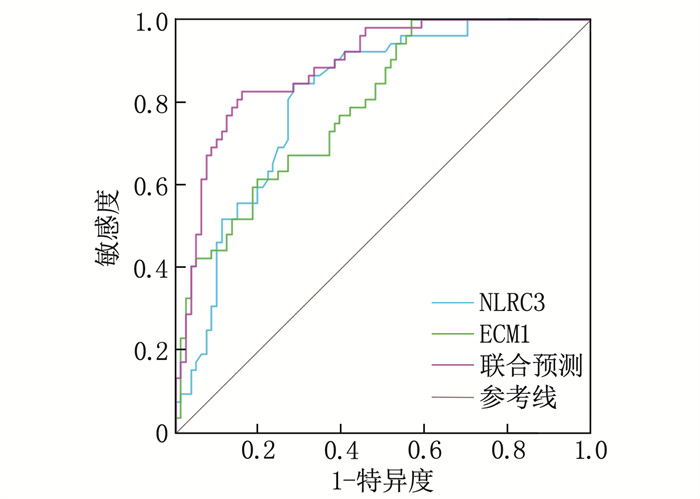Correlations of serum NLRC3 and ECM1 expression with acute respiratory distress syndrome in sepsis patients
-
摘要:目的
探讨脓毒症患者血清NOD样受体家族含CARD结构域蛋白3(NLRC3)、细胞外基质蛋白1(ECM1)表达与急性呼吸窘迫综合征(ARDS)的相关性。
方法选取脓毒症患者133例纳入脓毒症组,并选取同时间段体检健康者80例纳入对照组。根据是否并发ARDS分为ARDS组(52例)和非ARDS组(81例),采用酶联免疫吸附法检测血清NLRC3、ECM1表达。通过多因素Logistic回归分析筛选脓毒症患者并发ARDS的因素。采用受试者工作特征(ROC)曲线分析血清NLRC3、ECM1表达对脓毒症患者并发ARDS的预测价值。
结果与对照组比较,脓毒症组血清NLRC3表达降低, ECM1表达升高,差异有统计学意义(P < 0.05)。133例脓毒症患者ARDS发生率为39.10%(52/133)。与非ARDS组比较, ARDS组血清NLRC3表达降低, ECM1表达升高,差异有统计学意义(P < 0.05)。脓毒症患者并发ARDS的独立危险因素为序贯器官衰竭评估评分增加、血乳酸升高、ECM1升高,独立保护因素为NLRC3升高(P < 0.05)。血清NLRC3、ECM1表达联合预测脓毒症患者并发ARDS的曲线下面积为0.887,大于血清NLRC3、ECM1表达单独预测的0.811、0.792(P < 0.05)。
结论脓毒症患者血清NLRC3表达降低和ECM1表达升高与并发ARDS密切相关。血清NLRC3、ECM1表达联用对脓毒症患者并发ARDS有较高的预测价值。
-
关键词:
- 脓毒症 /
- NOD样受体家族含CARD结构域蛋白3 /
- 细胞外基质蛋白1 /
- 急性呼吸窘迫综合征 /
- 影响因素
Abstract:ObjectiveTo investigate the correlations of serum levels of NOD-like receptor family CARD domain containing 3 (NLRC3) and extracellular matrix protein 1 (ECM1) with the development of acute respiratory distress syndrome (ARDS) in patients with sepsis.
MethodsA total of 133 patients with sepsis were enrolled in sepsis group, and 80 healthy individuals during the same period were included in control group. The sepsis group was further divided into ARDS group (52 cases) and non-ARDS group (81 cases) based on the presence or absence of ARDS. Serum levels of NLRC3 and ECM1 expression were measured using enzyme-linked immunosorbent assays (ELISA). Multivariate Logistic regression analysis was used to identify factors associated with the development of ARDS in sepsis patients. Receiver operating characteristic (ROC) curve analysis was performed to evaluate the predictive value of serum NLRC3 and ECM1 levels for ARDS in sepsis patients.
ResultsCompared with the control group, the sepsis group had significantly lower serum NLRC3 level and higher ECM1 level (P < 0.05). The incidence of ARDS in the 133 sepsis patients was 39.10% (52/133). Compared with the non-ARDS group, the ARDS group had significantly lower serum NLRC3 level and higher ECM1 level (P < 0.05). Independent risk factors for the development of ARDS in sepsis patients were increased Sequential Organ Failure Assessment (SOFA) score, elevated blood lactate level and increased ECM1 level, while increased NLRC3 level was an independent protective factor (P < 0.05). The area under the curve for the combined prediction of serum NLRC3 and ECM1 expression in sepsis patients with ARDS was 0.887, which was greater than 0.811 and 0.792 predicted by serum NLRC3 and ECM1 expression alone (P < 0.05).
ConclusionDecreased serum NLRC3 level and increased ECM1 level are closely associated with the development of ARDS in sepsis patients. The combined assessment of serum NLRC3 and ECM1 level has a high predictive value for ARDS in sepsis patients.
-
急性缺血性脑卒中的治疗措施较多,包括特异性治疗、抗血小板聚集及溶栓治疗等,其中重组人组织型纤溶酶原激活物(rt-PA)静脉溶栓较为常用。阿替普酶属第2代溶栓药物,可活化纤溶酶原,降解纤维蛋白,属特异性纤维蛋白溶解剂[1-2]。脑苷肌肽注射液含有氨基酸、多肽及神经节苷脂等诸多成分,具有供能、营养及神经修复等功效,能恢复患者神经功能[3]。超敏C反应蛋白(hs-CRP)所介导的炎性反应在急性缺血性脑卒中发生、发展中具有重要作用,而胰岛素样生长因子-1(IGF-1)在脑组织生长发育及修复中具有重要作用。本研究探讨rt-PA静脉溶栓与脑苷肌肽注射液联合应用的效果,报告如下。
1. 资料与方法
1.1 一般资料
选取本院2015年6月—2017年12月急性缺血性脑卒中患者120例,随机数字表法分为2组各60例。对照组男33例,女27例; 年龄43~69岁,平均(56.21±6.69)岁; 发病至就诊时间1.2~4.3 h, 平均(2.71±0.79) h; 合并疾病包括糖尿病10例,高血压22例,冠心病5例,其他5例。研究组男36例,女24例; 年龄41~72岁,平均(55.97±7.02)岁; 发病至就诊时间1.0~4.5 h, 平均(2.68±0.81) h; 合并疾病包括糖尿病11例,高血压19例,冠心病6例,其他4例。本研究经本院伦理委员会审批通过。2组基线资料比较无显著差异(P>0.05)。
纳入标准: ①患者家属知晓本研究,签署同意书; ②发病至就诊时间≤4.5 h; ③经影像学检查确诊。排除标准: ①短暂性脑缺血发作者; ②合并脑部肿瘤、癫痫者; ③合并全身性重度感染性疾病者; ④合并免疫系统、血液系统及内分泌系统重度病变者; ⑤合并肝、肾等脏器器质性病变者; ⑥纳入研究前2周内行颅脑手术者; ⑦颅内出血者。
1.2 方法
对照组采用rt-PA(Boehringer Ingelheim Pharma GmbH & Co. KG, 批准文号S20110051)静脉溶栓治疗,应用剂量为0.9 mg/kg, 于1 min静脉推注10% rt-PA药量, 1 h内静脉滴注完成其余90%药量; 24 h后颅脑CT检查,无出血后服用氯吡格雷75 mg/d及阿司匹林200 mg/d。
研究组在对照组基础上加用脑苷肌肽注射液(吉林振澳制药有限公司,国药准字H22025067), 将脑苷肌肽注射液6~10 mL加入5%质量浓度的葡萄糖注射液250 mL中静脉滴注, 1次/d。2组均治疗14 d。
1.3 观察指标
① 治疗前及疗程结束后,评价2组日常生活能力及神经功能缺损评分,神经功能依据美国国立卫生研究院卒中量表(NIHSS)评估,分值越低越好; 日常生活能力依据日常生活活动能力(ADL)量表评估,分值越高越好。②依据NIHSS评估临床疗效, NIHSS评分降低不足45%为无效; NIHSS评分降低45%~ < 80%为有效; NIHSS评分降低≥80%为显效; 总有效率= (显效+有效)/总例数×100%[4]。③采用酶联免疫吸附法测定治疗前及疗程结束后的hs-CRP、IGF-1水平。④记录并比较2组不良反应。
1.4 统计学方法
采以SPSS 18.0对数据进行分析,计量资料以均数±标准差表示,行t检验,计数资料采用[n(%)]表示,行χ2检验, P < 0.05为差异有统计学意义。
2. 结果
研究组总有效率91.67%, 显著高于对照组71.67%(P < 0.05)。见表 1。2组治疗前NIHSS及ADL比较无显著差异(P>0.05); 2组疗程结束后NIHSS较治疗前显著降低, ADL较治疗前显著增高,且研究组显著优于对照组(P < 0.05)。见表 2。治疗前, 2组血清hs-CRP及IGF-1水平无显著差异(P>0.05); 疗程结束后, 2组hs-CRP水平显著低于治疗前, IGF-1显著高于治疗前,且研究组显著优于对照组(P < 0.05)。见表 3。研究组不良反应发生率15.00%, 与对照组11.67%比较无显著差异(P>0.05)。见表 4。
表 1 2组临床疗效比较[n(%)]组别 n 显效 有效 无效 总有效 研究组 60 29(48.33) 26(43.33) 5(8.33) 55(91.67)* 对照组 60 21(35.00) 22(36.67) 17(28.33) 43(71.67) 与对照组比较, *P < 0.05。 表 2 2组NIHSS及ADL评分比较(x±s)分 组别 n NIHSS ADL 治疗前 疗程结束后 治疗前 疗程结束后 研究组 60 20.07±2.01 6.47±0.95*# 40.67±10.10 70.39±7.30*# 对照组 60 20.23±1.95 8.66±1.11* 41.02±10.29 61.34±6.43* NIHSS: 美国国立卫生研究院卒中量表; ADL: 日常生活活动能力量表。与治疗前比较, *P < 0.05; 与对照组比较, #P < 0.05。 表 3 2组血清hs-CRP及IGF-1水平比较(x±s)组别 n hs-CRP/(mg/L) IGF-1/(ng/mL) 治疗前 疗程结束后 治疗前 疗程结束后 研究组 60 12.34±3.41 3.19±0.87*# 32.86±4.14 56.15±5.69*# 对照组 60 12.53±3.53 4.64±1.01* 33.20±4.24 45.26±5.11* hs-CRP: 超敏C反应蛋白; IGF-1: 胰岛素样生长因子-1。与治疗前比较, *P < 0.05; 与对照组比较, #P < 0.05。 表 4 2组不良反应发生情况比较[n(%)]组别 n 呕吐 转氨酶增高 皮疹 恶心 总计 研究组 60 3(5.00) 3(5.00) 1(1.67) 2(3.33) 9(15.00) 对照组 60 1(1.67) 1(1.67) 2(3.33) 3(5.00) 7(11.67) 3. 讨论
急性缺血性脑卒中为脑部血流供给异常,致使对应供血区域脑组织因缺氧、缺血发生软化或坏死,并造成持久性或短暂性脑损伤,引发神经功能缺损症候群。早期改善脑组织缺氧、缺血状态是急性缺血性脑卒中治疗的关键,且应促使神经元及神经细胞修复与再生,避免脑损伤加剧[5]。
目前临床常应用抗凝、抗血小板聚集、溶栓等方案治疗急性缺血性脑卒中,其中静脉溶栓最为常用,其具有成本低、创伤小等特性,易被接受[6]。rt-PA为机体中天然存在的纤溶酶原激活剂,属第2代溶栓药物,用药后可有效溶解血块,且rt-PA对整个凝血系统不同组分系统性作用较轻,其作为纤溶酶原激活剂,对纤维蛋白亲和力较高,可特异性激活血栓内纤溶酶原,且引发出血的风险较低,不会引发系统性纤溶状态[7-8]。脑苷肌肽注射液也是临床治疗急性缺血性脑卒中的常用药物,其为天然活性多肽、氨基酸及多种神经节苷脂复方制剂,可减轻神经兴奋氨基酸对神经细胞、神经元毒性作用,还可增强红蛋白载氧能力,恢复脑组织血氧的正常供给。相关研究[9-10]指出,脑组织缺血可使大量氧自由基释放堆积,以致神经系统发生退行性病变,而脑苷肌肽注射液可提升抗氧化酶活性,减轻脂质过氧化反应,抑制神经细胞膜脂肪酸丢失,进而缓解神经元对氧自由基损伤造成的抵抗作用,减轻氧自由基对神经细胞及神经元的损伤程度。脑苷肌肽注射液中神经节苷脂成分可于神经元细胞膜合成中发挥重要作用,加速神经干细胞分化,并对三磷酸腺苷及腺苷酸环化酶活性予以调节,维持神经代谢,以此加速神经组织修复,且还可抑制兴奋性氨基酸异常释放,减少氧自由基生成量[11]。本研究中,研究组疗程结束后ADL及NIHSS优于对照组,总有效率显著高于对照组(P < 0.05), 提示常规治疗基联合rt-PA静脉溶栓、脑苷肌肽注射液,可更有效恢复急性缺血性脑卒中患者神经功能,恢复其日常生活能力。
本研究结果显示,研究组疗程结束后hs-CRP水平显著低于对照组, IGF-1水平显著高于对照组(P < 0.05)。研究[12]表明, hs-CRP为典型急性时相蛋白,若机体遭受损伤,则其血清含量会异常增高,并引起损伤局部的多核白细胞聚集与炎性介质生成,进而加剧损伤,且血清含量与急性缺血性脑卒中患者炎性反应程度存在正相关关系。IGF-1主要分布于中枢神经系统,可对抗兴奋性氨基酸毒性,减小脑血管阻力,抑制神经细胞凋亡,参与神经元生长及分化,调节神经递质生成,减轻脑损伤程度。本研究结果证实,联合用药方案在减轻急性缺血性脑卒中患者炎性反应程度及脑损伤程度方面更具优势。2组不良反应发生率无显著差异(P>0.05), 提示rt-PA静脉溶栓联合脑苷肌肽注射液安全性较好。
综上所述, rt-PA静脉溶栓联合脑苷肌肽注射液治疗急性缺血性脑卒中安全有效,可调节血清hs-CRP、IGF-1水平,改善神经功能及提高日常生活能力,且不会增加不良反应发生率。
-
表 1 2组血清NLRC3、ECM1表达比较(x±s)[M(P25, P75)]
组别 n NLRC3/(ng/mL) ECM1/(pg/mL) 脓毒症组 133 1.60(1.08, 2.28)* 147.96±36.69* 对照组 80 4.11(2.79, 5.77) 94.09±22.72 NLRC3: NOD样受体家族含CARD结构域蛋白3;
ECM1: 细胞外基质蛋白1。与对照组比较, * P < 0.05。表 2 2组一般资料和血清NLRC3、ECM1表达比较(x±s)[n(%)][M(P25, P75)]
指标 分类 ARDS组(n=52) 非ARDS组(n=81) χ2/t/Z P 性别 男 32(61.54) 46(56.79) 0.294 0.587 女 20(38.46) 35(43.21) 年龄/岁 68.71±8.53 65.86±8.59 1.870 0.064 吸烟史 19(36.54) 24(29.63) 0.691 0.406 饮酒史 13(25.00) 14(17.28) 1.165 0.280 合并症 脑血管病 10(19.23) 10(12.35) 1.175 0.278 糖尿病 27(51.92) 32(39.51) 1.978 0.160 冠心病 21(40.38) 28(34.57) 0.160 0.497 慢性肝病 6(11.54) 6(7.41) 0.251 0.616 高血压 22(42.31) 31(38.27) 0.215 0.643 感染部位 呼吸系统 15(28.85) 27(33.33) 3.035 0.695 血液系统 25(48.08) 29(35.80) 消化系统 4(7.69) 5(6.17) 神经系统 3(5.77) 7(8.64) 泌尿系统 3(5.77) 6(7.41) 其他 2(3.85) 7(8.64) SOFA评分/分 8.00(6.00, 10.00) 5.00(4.00, 7.00) -5.734 < 0.001 血肌酐/(μmol/L) 90.85(78.41, 107.95) 83.19(63.36, 107.28) -1.854 0.064 血尿酸/(μmol/L) 376.01(268.72, 577.25) 379.96(238.86, 469.17) -1.227 0.220 血红蛋白/(g/L) 101.19±28.97 110.23±23.80 -1.962 0.052 白蛋白/(g/L) 28.45±4.28 30.84±4.23 -3.171 0.002 降钙素原/(μg/L) 5.60(2.55, 9.55) 4.91(2.36, 7.05) -1.865 0.062 血乳酸/(mmol/L) 4.56(2.45, 6.51) 3.24(1.73, 4.01) -3.574 < 0.001 白细胞计数/(×109/L) 12.96(11.07, 15.75) 11.87(7.05, 14.73) -1.817 0.069 血小板计数/(×109/L) 161.50(118.84, 192.35) 207.89(104.17, 285.94) -1.674 0.094 NLRC3/(ng/mL) 1.09(0.73, 1.54) 1.95(1.48, 2.65) -6.050 < 0.001 ECM1/(pg/mL) 170.76±29.74 133.31±33.20 6.606 < 0.001 表 3 脓毒症患者并发ARDS的多因素Logistic回归分析
变量 β SE Wald χ2 P OR 95%CI SOFA评分增加 0.505 0.140 13.033 < 0.001 1.657 1.260~2.180 白蛋白升高 -0.143 0.079 3.241 0.072 0.867 0.742~1.013 血乳酸升高 0.383 0.169 5.158 0.023 1.467 1.054~2.043 NLRC3升高 -0.181 0.045 16.498 < 0.001 0.834 0.765~0.911 ECM1升高 0.040 0.011 13.061 < 0.001 1.040 1.018~1.063 表 4 血清NLRC3、ECM1表达对脓毒症患者并发ARDS的预测价值
指标 AUC 95%CI P Cut-off 敏感度/% 特异度/% Youden指数 NLRC3 0.811 0.735~0.874 < 0.001 1.60 ng/mL 84.62 71.60 0.562 ECM1 0.792 0.714~0.858 < 0.001 123.68 pg/mL 100.00 43.21 0.432 二者联合 0.887 0.820~0.935 < 0.001 0.37 82.69 83.95 0.666 -
[1] 中国医疗保健国际交流促进会急诊医学分会, 中华医学会急诊医学分会, 中国医师协会急诊医师分会, 等. 中国脓毒症早期预防与阻断急诊专家共识[J]. 中国急救医学, 2020, 40(7): 577-588. doi: 10.3969/j.issn.1002-1949.2020.07.001 [2] WENG L, XU Y, YIN P, et al. National incidence and mortality of hospitalized sepsis in China[J]. Crit Care, 2023, 27(1): 84. doi: 10.1186/s13054-023-04385-x
[3] 张书娟, 王勇, 代晓明, 等. 脓毒症相关急性呼吸窘迫综合征的危险因素及预后分析[J]. 中国急救医学, 2022, 42(4): 331-336. doi: 10.3969/j.issn.1002-1949.2022.04.011 [4] 宋凯, 湛立娜, 章静, 等. 脓毒症肺损伤相关信号转导通路研究进展[J]. 中国中西医结合外科杂志, 2023, 29(6): 854-858. doi: 10.3969/j.issn.1007-6948.2023.06.026 [5] 萧颖畴, 孙雯洁, 刘蓉蓉, 等. 模式识别受体NLRC3的生物学效应及在免疫相关疾病中的研究进展[J]. 细胞与分子免疫学杂志, 2023, 39(4): 376-382. [6] LI R T, ZHAO Y, ZHANG X, et al. NLRC3 participates in inhibiting the pulmonary inflammatory response of sepsis-induced acute lung injury[J]. Immunol Invest, 2023, 52(5): 567-582. doi: 10.1080/08820139.2023.2206445
[7] XIAO W L, YANG Y, CHU C Y, et al. Macrophage response mediated by extracellular matrix: recent progress[J]. Biomed Mater, 2023, 18(1): 13-14.
[8] SONG Y, WU Q, JIANG H J, et al. The effect of shionone on sepsis-induced acute lung injury by the ECM1/STAT5/NF-κB pathway[J]. Front Pharmacol, 2021, 12: 764247.
[9] ARDS DEFINITION TASK FORCE, RANIERI V M, RUBENFELD G D, et al. Acute respiratory distress syndrome: the Berlin Definition[J]. JAMA, 2012, 307(23): 2526-2533.
[10] 中国物联网智能辅助ARDS诊治专家组. 物联网辅助成人急性呼吸窘迫综合征诊治中国专家共识[J]. 中国临床医学, 2022, 29(5): 719-730. [11] SUN B S, LEI M X, ZHANG J Q, et al. Acute lung injury caused by sepsis: how does it happen?[J]. Front Med, 2023, 10: 1289194. doi: 10.3389/fmed.2023.1289194
[12] 中华医学会重症医学分会重症呼吸学组. 急性呼吸窘迫综合征患者俯卧位通气治疗规范化流程[J]. 中华内科杂志, 2020, 59(10): 781-787. doi: 10.3760/cma.j.cn112138-20200430-00439 [13] 徐宁, 贾娟, 李莉, 等. 血清miRNA-125b联合miRNA-133a早期诊断脓毒症合并急性呼吸窘迫综合征的价值[J]. 中国临床研究, 2023, 36(4): 537-541. [14] 中国中西医结合学会第三届普通外科专业委员会, 《中国中西医结合外科杂志》学术编辑委员会, 王西墨, 等. 脓毒症肺损伤中西医结合诊治专家共识[J]. 中国中西医结合外科杂志, 2020, 26(3): 400-408. doi: 10.3969/j.issn.1007-6948.2020.03.002 [15] 朱晴, 张逸雪, 刘洋, 等. 脓毒症的病理生理机制研究进展[J]. 中华医院感染学杂志, 2022, 32(16): 2551-2555. [16] ZHANG X, QIN W W, MA F G, et al. Leptin reduces ventilator-induced lung injury in rats by regulating NLRP3, NLRC4 and NLRC3[J]. J Biol Regul Homeost Agents, 2021, 35(1): 59-69.
[17] 张本旺, 李秋杰, 王强, 等. 大鼠呼吸机相关性肺损伤时NLRC3表达的变化[J]. 中华麻醉学杂志, 2019, 39(11): 1387-1390. [18] MAIMAITIAILI N, ZENG Y X, JU P N, et al. NLRC3 deficiency promotes hypoxia-induced pulmonary hypertension development via IKK/NF-κB p65/HIF-1α pathway[J]. Exp Cell Res, 2023, 431(2): 113755. doi: 10.1016/j.yexcr.2023.113755
[19] XU J Q, GAO C G, HE Y J, et al. NLRC3 expression in macrophage impairs glycolysis and host immune defense by modulating the NF-κB-NFAT5 complex during septic immunosuppression[J]. Mol Ther, 2023, 31(1): 154-173. doi: 10.1016/j.ymthe.2022.08.023
[20] 王雷, 张利鹏. 细胞焦亡在急性呼吸窘迫综合征中的研究进展[J]. 中华危重病急救医学, 2021, 33(2): 249-251. [21] 张实, 谢剑锋, 邱海波. 巨噬细胞极化在早期急性呼吸窘迫综合征炎症反应中的作用[J]. 中华内科杂志, 2019, 58(6): 472-475. [22] ZHANG Y G, LI X Z, LUO Z G, et al. ECM1 is an essential factor for the determination of M1 macrophage polarization in IBD in response to LPS stimulation[J]. Proc Natl Acad Sci U S A, 2020, 117(6): 3083-3092.
[23] ZHANG B, XUE Y, ZHAO J, et al. Shionone attenuates sepsis-induced acute kidney injury by regulating macrophage polarization via the ECM1/STAT5 pathway[J]. Front Med, 2021, 8: 796743.
-
期刊类型引用(9)
1. 胡彩杰,刘海伦. 脑苷肌肽注射液对开放性骨折患者血清C反应蛋白水平及伤口感染率的影响. 中国药物经济学. 2022(07): 83-86 .  百度学术
百度学术
2. 张海峰. 脑苷肌肽治疗缺血性脑血管病的临床疗效分析. 反射疗法与康复医学. 2022(09): 94-96+100 .  百度学术
百度学术
3. 彭锋. rt-PA静脉溶栓联合氯吡格雷治疗急性缺血性脑卒中的临床效果. 临床合理用药杂志. 2022(25): 49-51 .  百度学术
百度学术
4. 余经盛,肖骋. 神经介入联合阿替普酶静脉溶栓治疗急性缺血性脑卒中患者疗效及出血风险研究. 创伤与急危重病医学. 2021(02): 142-144 .  百度学术
百度学术
5. 郭锦辉,邓智建,卢乙众,朱岩岩. 芪蛭通络胶囊联合脑苷肌肽治疗脑梗死恢复期的临床研究. 现代药物与临床. 2021(04): 680-684 .  百度学术
百度学术
6. 祝孔辉,李浩,常建军. 早期双抗方案联合丁苯酞治疗急性缺血性脑卒中患者的效果. 黑龙江医药科学. 2021(04): 172-174 .  百度学术
百度学术
7. 孔侦宇,姬松波,李振科,张文,董荣臻. 神经介入联合静脉溶栓治疗急性缺血性脑卒中的效果观察. 中国实用医刊. 2021(20): 42-45 .  百度学术
百度学术
8. 李华秀. rt-PA静脉溶栓联合氯吡格雷治疗急性缺血性脑卒中的临床分析. 中西医结合心血管病电子杂志. 2021(23): 70-72 .  百度学术
百度学术
9. 马桂芳,韩常安. 醒脑启咽汤联合舌三针对卒中恢复期患者吞咽功能障碍的干预效果. 河北中医. 2020(01): 49-53 .  百度学术
百度学术
其他类型引用(0)




 下载:
下载:

 苏公网安备 32100302010246号
苏公网安备 32100302010246号
